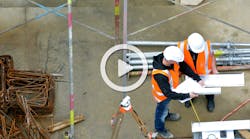One Deep Tunnel, Three Reservoirs: Cleaner Water
Since its inception, the Metropolitan Water Reclamation District of Greater Chicago’s (MWRDGC) Tunnel and Reservoir Plan (TARP) has not only abated flooding and pollution in the area, it has helped preserve the integrity of Lake Michigan. The main goals of TARP are to protect this Great Lake—the region’s drinking water supply for more than five million people—from raw sewage pollution, improve the quality of area waterways and provide an outlet for floodwater to reduce street and basement sewage backup flooding.
TARP was selected in 1972 as the Chicago area’s plan for cost-effective compliance with federal and state water quality standards with respect to the 375-sq-mile combined sewer area of Chicago and 51 adjacent suburbs. At a total cost of $3.5 billion, the system is designed to capture and store combined sewer overflow (CSO) in tunnels and reservoirs until it can be pumped to existing plants for treatment and released to local waterways.
Phase I: ‘Deep Tunnel’
The plan is being implemented in two phases. TARP Phase I, the “Deep Tunnel,” comprises projects intended primarily for pollution control. It captures and enables treatment of about 85 percent of the CSO pollution loading from TARP’s service area.
With a capacity of more than 2.3 billion gal, Phase I consists of 109.4 miles of rock tunnels, more than 250 drop shafts, three pumping stations and more than 600 surface-connecting and flow-control structures. The entire system of TARP Phase I was completed in 2006 and is now in operation.
To date, more than 950 billion gal of CSO have been captured and treated, including more than 900 million lb of biochemical oxygen demand and 1,700 million lb of solids that otherwise would have overflowed to area waterways.
Phase II: Three Reservoirs
The second phase of TARP involves three large reservoirs that are intended primarily for flood control but will also considerably enhance the pollution-control benefits provided under Phase I.
The reservoirs are being undertaken in a joint effort of the MWRDGC and the U.S. Army Corps of Engineers (USACE) under the Chicagoland Underflow Plan (CUP). The three reservoirs of TARP Phase II/CUP are the O’Hare, Thornton and McCook reservoirs, which will provide a combined 15.2 billion gal of storage.
As the local sponsor of TARP Phase II/CUP, the MWRDGC acquired land rights for the O’Hare Reservoir. The USACE designed and constructed the reservoir, which was completed in 1998. The district has since assumed its operation, and to date the reservoir has yielded $116 million in flood damage reduction benefits to the three communities it serves.
The Thornton Reservoir is being constructed in two stages. The first stage, a temporary 3.1 billion gal Natural Resources Conservation Service (NRCS) reservoir called the Thornton Transitional Reservoir, was completed in March 2003 in the west lobe of the Thornton Quarry. This reservoir provides overbank flood relief for nine communities and has captured 10.9 billion gal of floodwater during 20 fill events.
The second stage is a permanent 7.9-billion-gal combined NRCS/CUP reservoir called the Thornton Composite Reservoir, which will be constructed in the north lobe of the Thornton Quarry. This reservoir will provide 3.1 billion gal of storage for the NRCS overbank flooding area and 4.8 billion gal of storage for the TARP Phase II/CUP combined sewer area.
Mining of the north lobe for the Thornton Composite Reservoir commenced in 1998 and is on schedule to be completed in 2012. The composite reservoir will then be finished in 2014, after which the transitional reservoir in the west lobe will be decommissioned and returned to an active quarry. The Thornton Composite Reservoir will provide $40 million per year in benefits to 556,000 people in 15 communities.
The MWRDGC owns the land for the McCook Reservoir, which will be built within the Lawndale Avenue Solids Management Area. A project cooperation agreement with the USACE was signed on May 10, 1999.
The reservoir is planned to be constructed in two stages. The first stage will provide 3.5 billion gal of storage and should be completed in 2015. The second stage will provide 6.5 billion gal of storage and is scheduled for completion in 2023. The McCook Reservoir will provide $90 million per year in benefits to 3.1 million people in 37 communities.
Reclaiming Resources
Although construction of the entire TARP system is not fully completed, Chicago-area inland waterways have experienced a dramatic improvement in water quality. Rivers are once again abundant with many species of aquatic life, and riverfronts have been reclaimed as natural resources for recreation and development.
Reversal of the Chicago River, which allows untreated CSO to enter Lake Michigan, had occurred almost twice per year on average before the implementation of TARP. The reversal has only occurred once in the last five years. Upon completion of the reservoirs, even greater benefits should be realized in the Chicago region.
Download: Here

